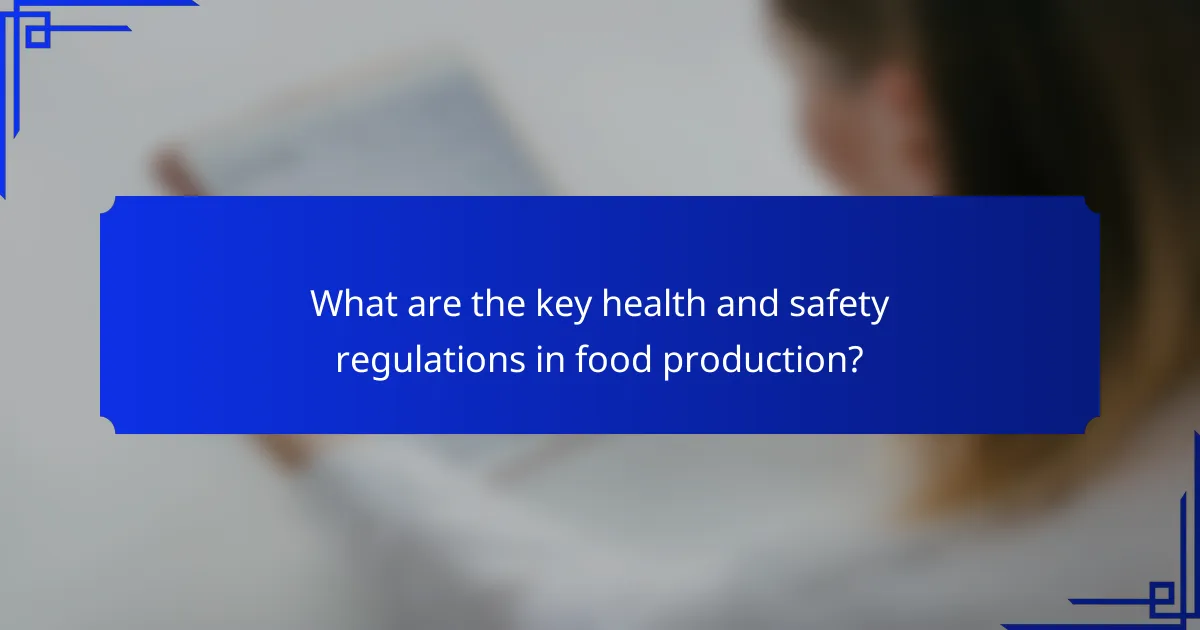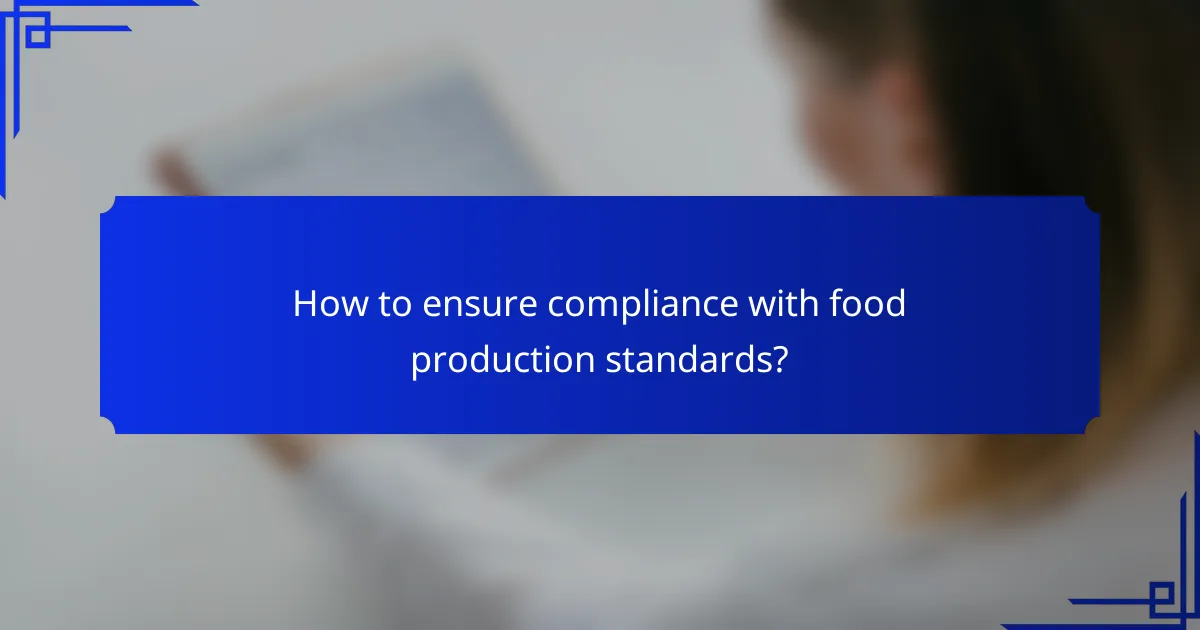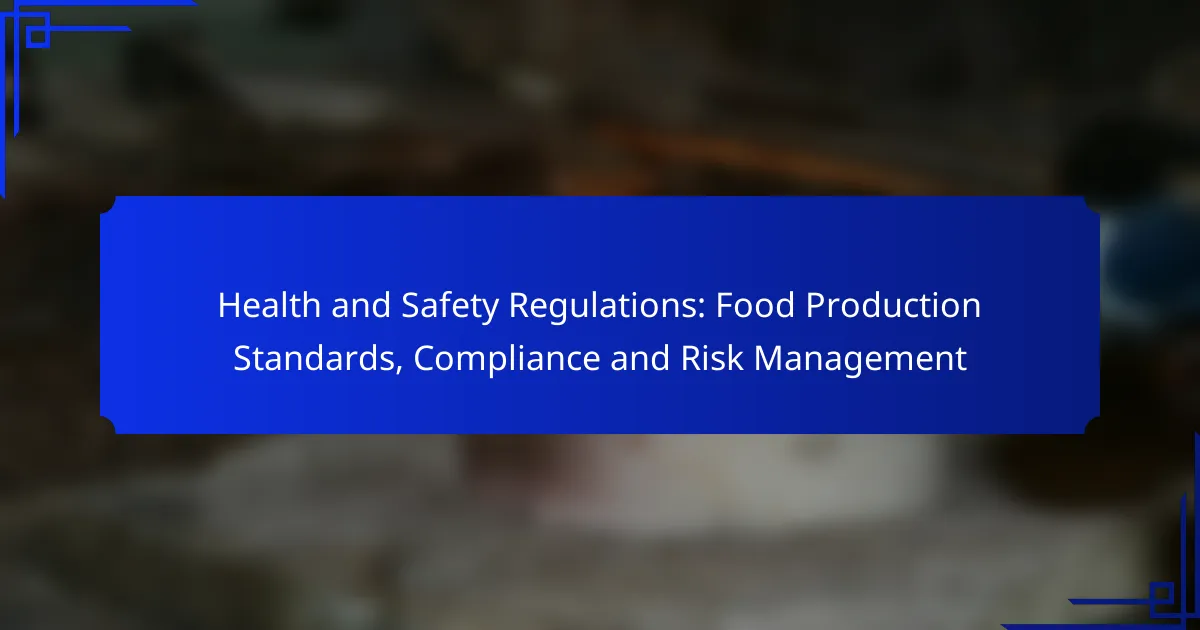Health and safety regulations in food production are essential for maintaining the safety and quality of food products, aiming to prevent foodborne illnesses and ensure compliance with legal standards. Businesses must adopt systematic processes, including regular audits and employee training, to mitigate risks associated with non-compliance, which can lead to legal issues and damage to reputation. By prioritizing these regulations, companies can safeguard their financial stability and maintain consumer trust.

What are the key health and safety regulations in food production?
The key health and safety regulations in food production focus on ensuring the safety and quality of food products. These regulations include standards and practices that help prevent foodborne illnesses and ensure compliance with legal requirements.
Food Safety Modernization Act (FSMA)
The Food Safety Modernization Act (FSMA) is a significant piece of legislation aimed at ensuring the safety of the U.S. food supply. It emphasizes preventive measures and requires food producers to implement risk-based controls to mitigate hazards.
Under FSMA, facilities must develop and maintain a food safety plan that includes hazard analysis and risk-based preventive controls. Compliance is monitored through inspections and can involve penalties for non-compliance.
HACCP Principles
Hazard Analysis Critical Control Point (HACCP) is a systematic approach to food safety that identifies potential hazards and establishes critical control points to manage them. This method is widely adopted in food production to ensure that food is safe for consumption.
Implementing HACCP involves seven principles: conducting a hazard analysis, determining critical control points, establishing critical limits, monitoring procedures, corrective actions, verification procedures, and record-keeping. These steps help producers systematically address food safety risks.
GMP Guidelines
Good Manufacturing Practices (GMP) guidelines are essential for ensuring that food products are consistently produced and controlled according to quality standards. These practices cover all aspects of production, from raw materials to finished products.
GMP includes proper facility design, equipment maintenance, employee hygiene, and thorough documentation. Adhering to GMP helps minimize risks of contamination and ensures that products meet safety regulations. Regular training and audits are crucial for maintaining compliance with GMP standards.

How to ensure compliance with food production standards?
To ensure compliance with food production standards, businesses must implement systematic processes that include regular audits, employee training, and thorough documentation. These practices help mitigate risks and maintain high safety and quality levels in food production.
Regular audits and inspections
Conducting regular audits and inspections is crucial for identifying potential compliance issues before they escalate. These evaluations should occur at scheduled intervals, such as quarterly or biannually, and can include both internal reviews and external assessments by regulatory bodies.
During audits, focus on critical areas such as hygiene practices, equipment maintenance, and adherence to safety protocols. Utilize checklists to ensure all aspects of the food production process are evaluated consistently.
Employee training programs
Implementing comprehensive employee training programs is essential for fostering a culture of compliance. Training should cover food safety practices, proper handling techniques, and awareness of relevant regulations. Regular refresher courses can help keep staff updated on any changes in standards.
Consider using a mix of training methods, including hands-on workshops, online courses, and assessments to cater to different learning styles. This approach not only enhances knowledge but also boosts employee confidence in maintaining compliance.
Documentation and record-keeping
Effective documentation and record-keeping are vital for demonstrating compliance with food production standards. Maintain detailed records of audits, training sessions, and any incidents that occur, as these documents serve as evidence during inspections.
Establish a systematic filing system, either digitally or physically, to ensure easy access to records. Regularly review and update documentation to reflect current practices and regulations, which helps in maintaining transparency and accountability.

What are the risks associated with non-compliance?
Non-compliance with food production standards can lead to significant risks, including legal repercussions, damage to reputation, and costly product recalls. These risks can affect a company’s financial stability and consumer trust.
Legal penalties and fines
Failure to comply with food safety regulations can result in severe legal penalties and fines. Regulatory bodies may impose fines that range from hundreds to thousands of dollars, depending on the severity of the violation. In some cases, repeated non-compliance can lead to criminal charges against company executives.
Companies should regularly review local regulations to ensure compliance and avoid unexpected penalties. Implementing a robust compliance program can mitigate risks and help maintain adherence to food safety laws.
Reputation damage
Non-compliance can severely damage a company’s reputation, leading to a loss of customer trust. Negative publicity from violations can spread quickly, especially through social media, impacting sales and brand loyalty. Rebuilding a tarnished reputation often takes considerable time and resources.
To protect their reputation, companies should prioritize transparency and proactive communication regarding their compliance efforts. Engaging with customers and stakeholders can help maintain trust even in challenging situations.
Product recalls
Product recalls are a direct consequence of non-compliance with food safety standards, often triggered by contamination or labeling issues. Recalls can be costly, involving logistics, disposal, and potential compensation for affected consumers. The financial impact can reach into the millions, depending on the scale of the recall.
To minimize the risk of recalls, companies should implement rigorous quality control measures and conduct regular audits of their production processes. Establishing a clear recall plan can also help manage the situation effectively if a recall becomes necessary.

How to implement effective risk management in food production?
Effective risk management in food production involves identifying potential hazards, assessing their impact, and implementing strategies to mitigate risks. This systematic approach ensures food safety and compliance with health regulations while protecting consumers and the business.
Risk assessment procedures
Risk assessment procedures in food production start with identifying hazards that could affect food safety, such as biological, chemical, or physical contaminants. After identifying these hazards, evaluate their likelihood and potential impact on consumers and operations.
Utilize tools like Hazard Analysis and Critical Control Points (HACCP) to systematically analyze risks. Regularly review and update your assessments to reflect changes in processes, regulations, or emerging risks.
Emergency response plans
Emergency response plans are essential for addressing unforeseen incidents that could compromise food safety, such as contamination events or equipment failures. These plans should outline clear procedures for containment, communication, and corrective actions.
Training staff on emergency protocols is crucial. Conduct regular drills to ensure everyone understands their roles during a crisis, which can significantly reduce response times and minimize risks to public health.
Continuous monitoring systems
Continuous monitoring systems are vital for maintaining food safety standards throughout production. Implement real-time monitoring of critical control points, such as temperature and humidity levels, to detect deviations promptly.
Utilize technology like IoT sensors for automated data collection and alerts. Regularly analyze monitoring data to identify trends and areas for improvement, ensuring proactive risk management and compliance with food safety regulations.

What are the best practices for food safety training?
The best practices for food safety training include engaging methods that ensure employees understand and comply with safety standards. Effective training enhances knowledge retention and promotes a culture of safety within food production environments.
Interactive training sessions
Interactive training sessions are essential for effective food safety training as they engage employees actively. Techniques such as role-playing, simulations, and group discussions can help reinforce key concepts and encourage participation.
Consider incorporating real-life scenarios that employees might face in their roles. This practical approach allows them to apply their knowledge and develop problem-solving skills relevant to food safety challenges.
Certification programs
Certification programs provide a structured way for employees to gain formal recognition of their food safety knowledge. These programs often cover essential topics such as hygiene practices, hazard analysis, and regulatory compliance.
Look for programs accredited by recognized organizations, as they often meet industry standards. Completing a certification can enhance an employee’s qualifications and demonstrate a commitment to food safety within the organization.
Regular refresher courses
Regular refresher courses are crucial to maintaining food safety knowledge over time. These courses help reinforce previously learned material and introduce updates on new regulations or best practices.
Schedule these courses at least annually, or more frequently if there are significant changes in regulations or procedures. This ongoing education helps ensure that all employees stay informed and compliant with current food safety standards.

How do local regulations vary in food safety compliance?
Local regulations for food safety compliance can differ significantly based on state and regional laws. These variations affect how food producers implement safety standards, conduct inspections, and manage risks associated with food production.
State-specific food safety laws
Each state in the U.S. has its own food safety laws that dictate the standards for food production and handling. For instance, California may have stricter regulations regarding organic labeling compared to Texas, which focuses more on meat processing standards. Understanding these specific laws is crucial for compliance and risk management.
Food producers should familiarize themselves with their state’s health department guidelines, which often include requirements for food handling, employee training, and facility inspections. Regular updates to these laws mean that staying informed is essential to avoid penalties and ensure consumer safety.
To ensure compliance, food businesses can create a checklist based on local regulations, including key areas such as temperature control, sanitation practices, and record-keeping. Engaging with local health inspectors can also provide insights into best practices and upcoming regulatory changes.
